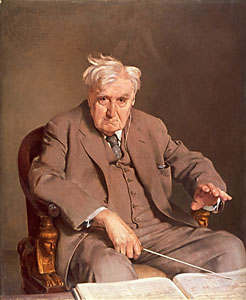In today’s Wall Street Journal “Sightings” column, inspired by a scene in the Roundabout Theatre Company’s revival of Look Back in Anger, I consider the seeming paradox of religious art created by skeptics. Here’s an excerpt.
* * *
Rarely have I seen a spectacle so disheartening as the cheerless, trash-strewn one-room flat that serves as the set for the Roundabout Theatre Company’s Off-Broadway revival of John Osborne’s “Look Back in Anger.” In this production, reviewed elsewhere in today’s Journal, the only hint of beauty comes from the radio on which the play’s unhappy characters listen to Ralph Vaughan Williams’ radiant Fifth Symphony. Small wonder that it should offer them a glimpse of comfort and joy in the midst of their emotional turmoil. Like so much of Vaughan Williams’ music, the Fifth Symphony, which was composed during World War II, is deeply spiritual in tone, and it’s no surprise to learn that it was based on themes from his operatic version of “The Pilgrim’s Progress.”
 Here’s the surprise: Vaughan Williams was a lifelong agnostic.
Here’s the surprise: Vaughan Williams was a lifelong agnostic.
Now that the boutique atheism of such aggressive secularists as Richard Dawkins, Sam Harris and Christopher Hitchens has become chic, you might well find yourself wondering why any unbelieving artist would bother to turn his hand to the making of religious art. Indeed, most of the modern novelists who have placed matters of faith at the center of their work have been, like Graham Greene, C.S. Lewis, François Mauriac and Flannery O’Connor, believers of one sort or another. But in every other branch of art, great works of devotional art have been created by skeptics, not a few of whom were fire-breathingly militant about their doubt….
How can such folk take up their tools in the name of God–and why would they want to do so? If you’re a person of faith, the answer is obvious: They are guided by divine grace, which theologians assure us can be perceived partially or not at all. But there are other explanations….
* * *
Read the whole thing here.
Sir Adrian Boult conducts the London Philharmonic in the first movement of Vaughan Williams’ Fifth Symphony:
Terry Teachout on the arts in New York City
An ArtsJournal Blog
